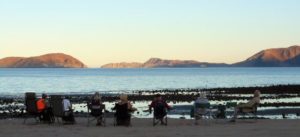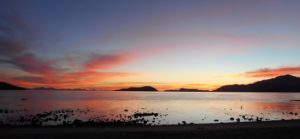
December 16, 2016 – Mulege, 2nd day was about the visit to town, banking, shopping for stuff, good chat with Claudia and Miguel, groceries and water, a little breezy but warm, never saw Don, wanted to offer our condolences as Nancy passed away earlier in the year, we are sure they were married for more than 50 years. We enjoyed our stay in Mulege and look forward to our return in January.
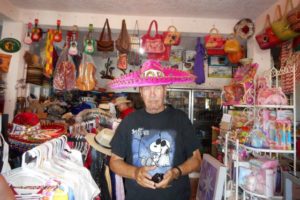
Guerrero Negro, our drive was uneventful, only one incident of concern, semi passed another after the climb from Santa Rosalia, on a rise, definitely potential for disaster high. Flurry of emails and phone calls to home, that included the local MLA office and Insurance Company, discovered we (I) never transferred Trailer Insurance from Storage to Travel Status.
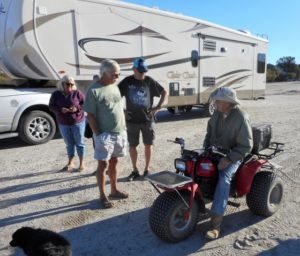
Next day we headed for Bahia de Los Angeles, departed early, a theme with this group, weather overcast and cool, but not cold. Military check point just waived us thru, as we were all together as a group with no interlopers in-between. I did explain we were all Canadians on vacation heading Bahia de Los Angeles. By the time we made the junction to LA Bay, only sunshine and no wind. Conditions could not be better for our arrival, blue skies, calm seas, no wind, stayed that way all day.
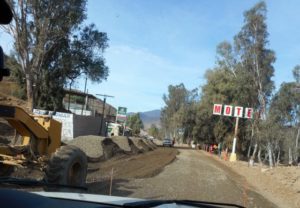
Almost all highway damage from Odile was now repaired. this should all be complete when January group arrives. Lisa and I took new road to La Gringa, unfortunately the last 2 km not finished, and was very rough. Many in group surprised with the beauty of LA Bay, because of calm weather and brilliant sunny skies, fond memories of this place for sure. Did a drive about for photos, and the next day Museo and other town sites. Unfortunately Bety & Antonio Jr not home, they were in Ensenada shopping. Dropped gifts off with folks we had met before staying in Palapa. We will drop in January and see if we can catch up with them then.ririano

Everyone enjoyed the Museo; Carolina was on duty, it seems the new road to La Gringa is a mystery to folks in town as 10 times the population lives out the other direction. David purchased a bottle of Tequilla as a donation to the Happy Hours, that sure will be fun later. Stop to shop for a few more items, then we returned to beach to drop everyone off. Back to town to fill up then Lisa and I walked a little on the beach and later we had a Happy Hour and tried out David’s purchase, actually very smooth, the 3 beers included not so much, this had likely sat on the shelf for years. Our stay in Bahia was remarkable, perfect weather and a great group and we even had the Dolphins show up before our departure.
Headed of at 9:30 am to Catavina, we break up the drive from Bahia to Vicente Guerrero into 2 parts on longer tour. Took us just under 3 hours, the first hour to the Hwy a breeze, no traffic great surface, next section not so much, more Big Rigs than we had see on the entire tour and really Crappy pavement. We learned Robert & Corrine lost a hub cap from a Pot Hole. When we arrived at Santa Ines Ralph was just finishing straightening a Travel Trailer axel some folks folks from Oregon (Robert & Jackie) limped in with, they are heading north for new springs and axels. Later they joined us for our Happy Hour, we even got Ralph to have a shot of Tequilla and join us.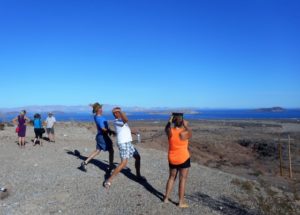
Next morning we set off before 8:30 am for Vicente Guerrero and the Posadsa Don Diego RV Park. The drive was uneventful, again perfect weather, sunny skies and no wind. We did drop into the Onyx Shop and it was open, although much less stock than we have seen before. It appears Lisa & Luis have moved on, we have not seen them for over a year at the store. We were waived thru both Military Checkpoints, which is very unusual, only Dave & Deanna were boarded, likely curious what the young folks are doing with all these old farts. Before you knew it we had arrived at the RV park in Vicente Guerrero. After several phone calls and being on hold for some time Emily from our local MLA office found a direct phone number to call to renew our Tango Trailer Travel Insurance, once again turning challenge into achievement, what a dumb ass I was. Abby picked us up in 2 vehicles for dinner at Baja Fiesta, everyone had a great meal and really enjoyed dinner. It was good to see Cecilia and Ron, we will be back.
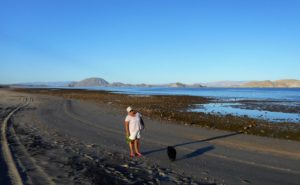
Day 38 and we are headed to Sordo Mudo. We ran into some construction as we descended into the Santo Tomas Valley, the other section prior to that from Coyote Cals north was now complete, just wonderful to drive on. Our drive thru Ensenada went flawlessly and we arrived at Sordo Mudo at 12:30 pm. At 1:55 pm we load the Van and headed to LA Cetto for the Tour and Tasting. Adriano was our guide and the gang enjoyed his presentation and the wine they tasted. The groups was impressed on the scale, size and state of the LA Cetto facility, they had no idea Mexico was producing from these kinds of facilities. We returned to the Campground and met with Johnny, the school principal. Sonya had organized a collection of items and cash for the school and students, it was several bags in the end. Johnny was very thankful for the donations and did a good job explaining the work they did including the history of the school.

Day 39 and the tour is over and we head back to the US, we departed early at 7 am after Dave changed a flat on the trailer in the rain. We arrived at the border at 8:30 am with only a few cars in front of us. Fantastic for sure! Only Dave & Deanna and Corrine & Robert were put thru the Ag Check, they lost all their shells. First time that has ever happened. We said our goodbyes and now we are in Oak Creek, pissing rain and windy as hell, welcome north. Be for you know it we will be back in BC for Xmas, sounds like in the snow.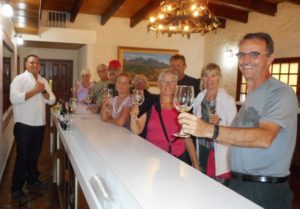
Merry Xmas – Feliz Navidad
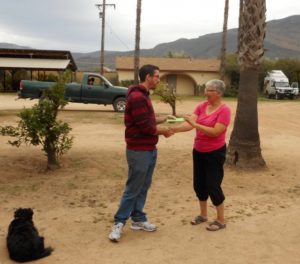
Did you know?
The Colorado River Delta is the region where the Colorado River flows into the Gulf of California (also known as the Sea of Cortez). The delta is part of a larger geologic region called the Salton Trough. Historically, the interaction of the river’s flow and the ocean’s tide created a dynamic environment, supporting freshwater, brackish, and saltwater species. Within the delta region, the river split into multiple braided channels and formed complex estuary and terrestrial ecosystems. Use of water upstream and the accompanying reduction of fresh water flow has resulted in loss of most of the wetlands of the area, as well as drastic changes to the aquatic ecosystems. However, a scheme is currently in place which aims to rejuvenate the wetlands by releasing a pulse of water down the river delta.
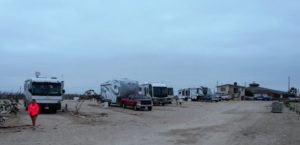
Natural history
Until the early 20th century, the Colorado River ran free from its headwaters in the Rocky Mountains of Colorado southwest into Mexico, where it flowed into the Gulf of California. Significant quantities of nourishing silt from throughout the Colorado River Basin were carried downstream, creating the vast Colorado River Delta. Prior to the construction of major dams along its route, the Colorado River fed one of the largest desert estuaries in the world. Spread across the northernmost end of the Gulf of California, the Colorado River delta’s vast riparian, freshwater, brackish, and tidal wetlands once covered 7,810 km² (1,930,000 acres) and supported a large population of plant, bird, aquatic, and terrestrial life. Because most of the river’s flow reached the delta at that time, its freshwater, silt, and nutrients helped create and sustain a complex system of estuarial wetlands that provided feeding and nesting grounds for birds, and spawning habitat for fish and marine mammals. In contrast to the surrounding Sonoran Desert, the Colorado River delta’s abundance was striking.
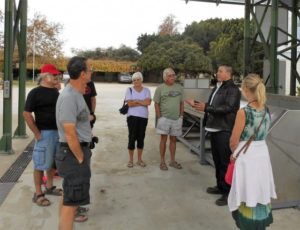
Early history
Early explorers reported jaguars, beavers, deer, and coyotes in the delta, in addition to the abundance of waterfowl, fish, and other marine and estuary organisms {Aldo Leopold, 1948}. Early explorers also encountered local people known as the Cucapá, or the people of the river. The Cucapá are descendants of the Yuman-speaking Native Indigenous peoples of the Americas and have inhabited the delta for nearly a thousand years. Spanish explorer Hernando de Alarcón made the first recorded contact with the Cucapá in 1540 and reported seeing many thousands. The Cucapá used the delta floodplain extensively, for harvesting Palmer’s saltgrass (Distichlis palmeri), a wild grain which grows in salty soil; and for cultivating maize (corn), beans, and squash. “On the map the Delta was bisected by the river, but in fact the river was nowhere and everywhere, for he could not decide which of a hundred green lagoons offered the most pleasant and least speedy path to the Gulf.”
–Aldo Leopold, from A Sand County Almanac, describing the Colorado River Delta as it existed in 1922.

Post dam construction
Today, conditions in the delta have changed dramatically. Like other desert river deltas, such as the Nile Delta and the Indus River Delta, the Colorado River delta has been greatly altered by human activity. Decades of dam construction and water diversions in the United States has reduced the delta to a remnant system of small wetlands and brackish mudflats. As reservoirs filled behind dams and captured floodwaters, freshwater could no longer reach the delta. The construction of Hoover Dam in the 1930s marked the beginning of the modern era for the Colorado River Delta. For six years, as Lake Mead filled behind the dam, virtually no freshwater reached the delta. Even spring flooding was captured.

This ecologically devastating event was repeated from 1963 to 1981 as Lake Powell filled behind the Glen Canyon Dam. With these reservoirs now filled, the dams are used to regulate flow so that water can be reliably apportioned among the users of the Colorado River Compact, and its use maximized. Most flood flows can be contained, regulated, and added to the river’s capacity to sustain the Western United States’ urban centers and agriculture. Floodwaters are released only when the Bureau of Reclamation, the agency managing the dams, predicts flows that exceed the system’s capacity for use and storage.
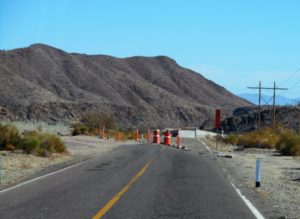
The loss of freshwater flows to the delta over the twentieth century has reduced delta wetlands to about 5 percent of their original extent, and non-native species have compromised the ecological health of much of what remains. Stress on ecosystems has allowed invasive plants to out compete native species along Colorado River riparian areas. Native forests of cottonwood and willow have yielded to sand and mudflats dominated by the nonnative tamarisk (also known as salt cedar), arrowweed, and iodinebush, a transformation that has decreased the habitat value of the riparian forest.
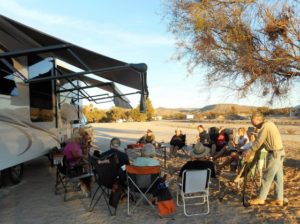
High flows in 1980s
Full reservoir conditions coupled with a series of flood events throughout the 1980s and early 1990s resulted in flood releases that reached the delta. These flows re-established an active floodplain and revegetated many areas of the floodplain within irrigation and flood control levels, and helped to re-establish riparian forests.

Ecology
The delta supports a variety of wildlife, including several threatened and endangered species. Mexico’s Environmental Regulations on Endangered Species lists the following endangered species found in the terrestrial and aquatic regions of the delta (Diario Officiel, 1994):
• the desert pupfish, also listed as an endangered species in the U.S., the largest remaining population anywhere is in La Ciénega de Santa Clara
• the Yuma rail, also listed as endangered in the U.S.
• the bobcat
• the vaquita porpoise, the world’s smallest marine cetacean, listed as a species of special concern by the U.S. Marine Mammal Commission. There are thought to be less than 250 vaquita left in the world.
• the totoaba, now virtually extinct, a steel-blue fish that grows up to 2 m (7 ft) and 136 kg (300 pounds), and once supported a commercial fishery that closed in 1975 (Postel et al., n.d.).
• the Colorado delta clam, once an extremely abundant species and important in the trophic dynamics of the ecosystem.

Although not extensively studied, the delta’s significance for migratory birds is indisputable, as it is the principal freshwater marsh in the region. A total of 358 bird species have been documented in the Colorado River Delta and upper Gulf of California region. From these, two are listed as endangered, six as threatened, and sixteen are under special protection in Mexico. Two wintering species and five breeding species have been locally extirpated, including the southwestern willow flycatcher, the Fulvous whistling duck, and the Sandhill crane.
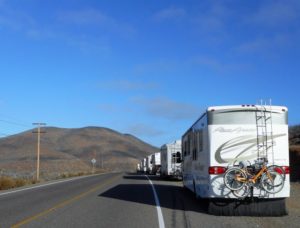
Biosphere reserve
The Gulf of California lies within the jurisdictional boundaries of Mexico and its states of Baja California and Sonora. In 1974, the Mexican government designated portions of the upper Gulf and lower Colorado River Delta as a reserve zone. The United Nations Educational, Scientific and Cultural Organisation (UNESCO) designated over 12,000 km² (3 million acres) of Upper Gulf of California and Colorado River Delta Biosphere Reserve as a Biosphere Nature reserve in June 1993. Within this 12,000 km² (3 million acres), over 4,000 km² (1 million acres) nearest the Colorado River Delta are designated as the Reserve “core area”, with the remaining 8,000 km² (2 million acres) of open water and shoreline designated as a “buffer area”. UNESCO considers areas for designation as Biosphere Reserves only after the nation in which the site is located submits a nomination. Once designated, Biosphere Reserves remain under the sovereign jurisdiction of the countries where they are located. Federal Mexican governmental agencies with administrative authority over the Biosphere Reserve include the National Commission of Protected Natural Areas (CONANP) and the Secretary of the Environment, Natural Resources and Fisheries (SEMARNAP). In addition to designation as a Biosphere Reserve, 2500 km² (618,000 acres) within Colorado River Delta (Humedales del Delta del Río Colorado) are designated as a Ramsar Wetland under the U.N. Convention on Wetlands. Ramsar Wetlands are wetlands of international importance in terms of their ecology, botany, zoology, limnology or hydrology. The U.N. designation is considered following a nomination by the nation in which the site is located.